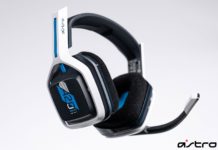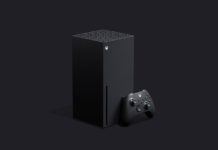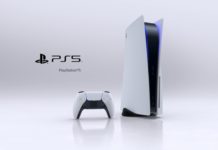Splatoon is an odd game. It’s not just odd in the concept of you being a squid-like humanoid with weapons that shoot paint… and not just odd because of crazy Inklings that live in the sewer, but odd in the way it’s implemented for Nintendo. Nintendo is known to take risks, and Splatoon is a risk. It’s a new IP — a weird one at that — that’s more of a family-friendly take on the third-person shooter genre. It’s an incredibly fun game… much more fun that I expected it to be, but a few curious decisions keep Splatoon from reaching its true potential.
In Splatoon, you’ll battle against other players in a turf-war, covering the map in your team’s ink, which constantly changes the map and how you can use it. You’ll use weapons like a giant paint roller to cover more and more of the map, and transform into a squid to travel quickly across your ink, camouflage yourself, or to go up ramps and gain the high ground advantage. It’s very active, very messy, very colorful, very chaotic, and very fun.

Splatoon is primarily a multiplayer game, designed to be played online with two teams of four players battling it out. This brings me to my first oddity with the game. Local play in games like Mario Kart and Super Smash Bros. make the Wii U worth owning. I would count Splatoon into this if it wasn’t for the reliance on online play. In order to increase your level to get perks and currency to get more weapons and customization options, you need to play online — either in regular or ranked matches. There’s only one option for local play, and that’s a 1v1 matchup where you and a friend battle it out to see who can pop the most balloons. The lack of a splitscreen local play mode is baffling. You also can’t progress your rank by playing locally.
At launch, Splatoon features five maps, two modes, and a short campaign for single player that actually plays very differently than the multiplayer. Though that looks like a lackluster offering, Splatoon will constantly be updated with new gear, weapons, maps and modes. The main mode that you’ll be playing a ton of in online games is Turf War. It’s an eight-player, 4v4 mode where both teams try to cover the maps with their ink. The team that has most of the map covered at the end wins. Post-launch modes include Splat Zones (ranked) that has teams fighting for control of capture points; Tower Control (ranked); and Rainmaker, which has no information released as of now. There’s also Splatfests, which are events where players choose a faction to fight for, and at the end of it, you’ll get unique rewards.

With online play, matchmaking started terribly, but has since been quick and concise. There's really no way to back out of a game, and while there’s a mini-game you can play while you wait, it would be nice if you could change your loadout or do something worthwhile while waiting. While I questioned Splatoon's lasting appeal before launch, more content, matches, maps and weapons have been added, and it's turning out to be the game is should have been from the get-go. For someone that’s used to a more robust shooter experience, Splatoon isn't as diverse as other offerings out there, but it's a ton of fun and different than any shooter out there.
While you’ll try out new weapons, I found that there are a few weapons that are overpowered, so it doesn’t make much sense to use anything else. That said, there are plenty of options for weapons that you can choose from, and you’ll be able to find them in the game’s main hub — Inkopolis.
Inkopolis is a plaza with shops that acts as the main hub, and it’s one of the cooler parts of the game. From there, you’ll choose whether you want to play single-player or multiplayer, and you’ll find shops to buy new weapons and clothing with the money you get from playing online matches. You’ll be visiting a NPC named Sheldon for your main weapons, sub weapons and special weapons. Each weapon has variations, and you could put together the right combination of weapons that works best for you. For attire, you’ll find multiple shops with a specialization for each — one for shoes; one for headgear and hats; and another for shirts, hoodies and tops. Gear can also be leveled up with ability slots the more you use that gear.

If you want to play offline or by yourself, the single-player campaign is about six to seven hours long and plays quite differently than online matches. There’s light puzzle mechanics, some platforming, and there’s boss fights. Some of the stages can get challenging, but the campaign is a good way to learn the deep ins-and-outs of the game. However, once you beat it, there’s no replay value there, nor will you get currency that you can use to upgrade your character. The only reason worth revisiting each level is to seek out and collect the hidden Sunken Scrolls which depict the history of Inkopolis.
As far as controls are concerned, you'll have the option of using the gyroscope on the GamePad to use motion-based aiming. It's default setting is motion, but it's not going to be everyone's cup of tea. Personally, I prefer standard controls for aiming and movement, so I switched motion to off and used the left and right sticks for movement and aiming. I can see the perks of using motion controls, but it's going to be a preference thing for each player.
Splatoon is a refreshing new IP, and one that is getting better over time. It’s a fun game that I feel good about letting my kids play online (mainly thanks to no online chat, which I’m totally okay with), but it’s sorely lacking a more robust splitscreen multiplayer that would kick it up a notch. The game is vibrant, runs smooth and looks gorgeous, and it embraces all of its quirkiness. However, there’s not a ton of content right now, and all of the game’s upgrades revolve around playing multiplayer matches. The potential is there for something special; we just have to see if Splatoon can reach its potential with all of the free content.
Splatoon was reviewed with a provided digital code









